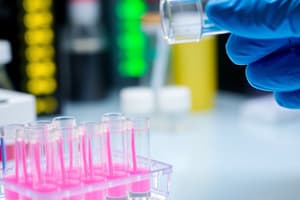Podcast
Questions and Answers
What is the primary purpose of using oligo primers in PCR?
What is the primary purpose of using oligo primers in PCR?
- To amplify the DNA fragment between them (correct)
- To increase the temperature of the reaction
- To bind with free nucleotides only
- To completely separate the DNA strands
At what temperature does the DNA denaturation step occur in PCR?
At what temperature does the DNA denaturation step occur in PCR?
- 95 degrees (correct)
- 54 degrees
- 37 degrees
- 72 degrees
Which factor does NOT affect the migration of nucleic acids in agarose gel electrophoresis?
Which factor does NOT affect the migration of nucleic acids in agarose gel electrophoresis?
- Size of nucleic acid
- Voltage across the gel
- Base composition of the nucleic acid
- Temperature of the gel (correct)
What is the function of the loading buffer in agarose gel electrophoresis?
What is the function of the loading buffer in agarose gel electrophoresis?
What type of DNA structure does NOT affect its migration speed through agarose gel?
What type of DNA structure does NOT affect its migration speed through agarose gel?
Which property of agarose gel affects the pore size through which nucleic acids migrate?
Which property of agarose gel affects the pore size through which nucleic acids migrate?
Which fluorescent dye is used for staining nucleic acids in agarose gel electrophoresis?
Which fluorescent dye is used for staining nucleic acids in agarose gel electrophoresis?
Which step in PCR follows the annealing of the primers?
Which step in PCR follows the annealing of the primers?
Flashcards
PCR: Polymerase Chain Reaction
PCR: Polymerase Chain Reaction
A laboratory technique used to amplify specific DNA sequences by repeatedly copying them with a DNA polymerase enzyme, using a cycle of heating and cooling.
Primers in PCR
Primers in PCR
Two short single-stranded DNA sequences that are complementary to the target DNA region that you want to amplify.
Agarose Gel Electrophoresis
Agarose Gel Electrophoresis
The process of separating DNA fragments based on their size and charge using an electric current through a gel matrix.
Loading buffer in Agarose Gel Electrophoresis
Loading buffer in Agarose Gel Electrophoresis
Signup and view all the flashcards
Template DNA in PCR
Template DNA in PCR
Signup and view all the flashcards
Voltage in Agarose Gel Electrophoresis
Voltage in Agarose Gel Electrophoresis
Signup and view all the flashcards
Fluorescent dyes in Agarose Gel Electrophoresis
Fluorescent dyes in Agarose Gel Electrophoresis
Signup and view all the flashcards
Agarose concentration in Agarose Gel Electrophoresis
Agarose concentration in Agarose Gel Electrophoresis
Signup and view all the flashcards
Study Notes
PCR (Polymerase Chain Reaction)
- PCR amplifies a specific DNA region.
- Primers (20-30 nucleotides long) bind to target DNA sequences.
- DNA polymerase synthesizes new DNA strands using free nucleotides (dNTPs).
- Cycles involve melting DNA, annealing primers, and extending strands.
- Starting material can be genomic or plasmid DNA.
- Steps include:
- Melting double-stranded DNA at 95°C.
- Annealing primers at 54°C.
- Adding nucleotides and polymerase to extend strands.
- Repeating cycles of melting, annealing, and extension to amplify the target region.
Agarose Gel Electrophoresis
- Separates charged molecules (nucleic acids) based on size.
- Factors affecting migration:
- Nucleic acid size (base pairs).
- Nucleic acid conformation (supercoiled, circular, linear).
- Base composition (different bases have different pI values).
- Voltage across the gel (higher voltage = faster migration).
- Agarose gel density (higher density = slower migration).
- Monitoring: loading samples contain dyes (Xylene cyanol FF and bromophenol blue) and Ficoll (increases sample density).
- Dyes mark nucleic acid sizes (4000-300 base pairs).
- Staining: GelRed (non-toxic fluorescent dye) stains nucleic acids.
- Imaging: UV transilluminator visualizes the separated DNA bands.
Studying That Suits You
Use AI to generate personalized quizzes and flashcards to suit your learning preferences.
Description
This quiz covers essential molecular biology techniques, specifically PCR and agarose gel electrophoresis. Participants will explore the principles of DNA amplification through PCR, including the roles of primers and DNA polymerase, as well as the methods for separating nucleic acids based on size using gel electrophoresis.




